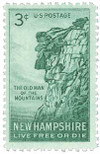
# 1068 - 1955 3¢ New Hampshire
1955 3¢ Old Man of the Mountain
New Hampshire Issue
City: Franconia, New Hampshire
Quantity: 125,944,400
Printed by: Bureau of Engraving and Printing
Printing Method: Rotary Press
Perforations: 10 ½ x 11
Color: Green
On May 3, 2003, the Old Man of the Mountain rock formation in New Hampshire collapsed.
The 40-foot-tall face in New Hampshires White Mountains was composed of Conway red granite. Five ledges formed its appearance. When lined up, these ledges gave the appearance of an old man looking to the east. According to geologists, a combination of the glacial movement and the forces of seasonal freezing sculpted the face. It is believed the old man had existed for as long as 10,000 years.
1955 3¢ Old Man of the Mountain
New Hampshire Issue
City: Franconia, New Hampshire
Quantity: 125,944,400
Printed by: Bureau of Engraving and Printing
Printing Method: Rotary Press
Perforations: 10 ½ x 11
Color: Green
On May 3, 2003, the Old Man of the Mountain rock formation in New Hampshire collapsed.
The 40-foot-tall face in New Hampshires White Mountains was composed of Conway red granite. Five ledges formed its appearance. When lined up, these ledges gave the appearance of an old man looking to the east. According to geologists, a combination of the glacial movement and the forces of seasonal freezing sculpted the face. It is believed the old man had existed for as long as 10,000 years.









